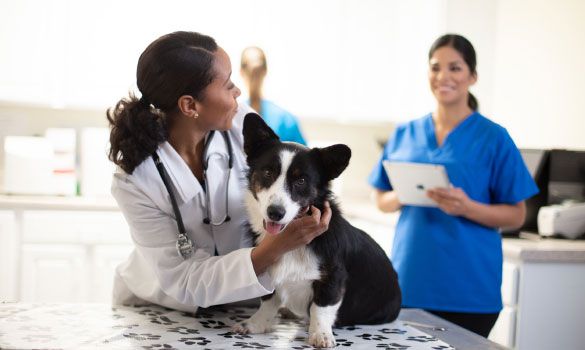IDEXX in-house analyzers
Artificial intelligence in veterinary medicine leads to efficiency and superior accuracy
In 2021, virtually all areas of life benefit from artificial intelligence (AI) applications. Veterinary medicine is no exception. The use of AI in the field is growing steadily and can be observed in diagnostics in particular.
Large data sets of patient images and results are being used to train AI software to detect complex diseases with increasing accuracy. Some practice management systems employ AI systems to interpret veterinary results to recommend diagnostic alternatives and next steps. There are even AI-powered stethoscopes that help identify arrhythmias and other cardiac-related disorders. And these are just a few of AI’s numerous use cases in veterinary medicine. In a nutshell, veterinarians can now look to technology for intelligent and reliable clinical decision support.

Here's a look at how AI can help you practice veterinary medicine with superior accuracy and increased efficiency.
Real-time care efficiencies
The advanced technology available today is reshaping the way veterinarians and their teams work, adding valuable efficiency and improving real-time care. Imagine a workflow that reduces the need for you to identify cells by manual microscopy—the entire element identification process automated. With AI-backed veterinary technology, you can have accurate results from analyzing patient urine samples within minutes.
That’s how it is with the SediVue Dx Urine Sediment Analyzer. Its inverted microscope and high-quality digital camera generates images that are evaluated by the analyzer’s AI.
Specifically, the analyzer informs you of:
- Absence or presence of bacteria rods or cocci
- The types of cells present—it identifies red blood cells, white blood cells, squamous epithelial cells, and nonsquamous epithelial cells
- The types of crystals present—it identifies calcium oxalate dihydrate, struvite, ammonium biurate, and bilirubin as well as atypical crystals
- The type of casts present—it identifies hyaline and nonhyaline casts
The analyzer not only generates results fast, it also provides you with the images you can use to educate your clients. With less time using manual microscopy, you and your team can spend more time explaining the results to clients and treating patients.
Superior accuracy in diagnosing patients
Beyond increasing efficiencies, diagnostic analyzers are now being built with AI that provides unparalleled clinical insight.
As one of the tests run and relied on most in veterinary medicine, getting trusted, detailed and accurate results from a complete blood count (CBC) is a priority. With the advancement of AI and machine-learning techniques, blood cell identification methods are becoming faster and more accurate. And preprogrammed algorithms are being used to facilitate the identification of common abnormal patterns in CBC results.
The ProCyte One Hematology Analyzer leverages similar technology. Its AI uses the analyzer’s sophisticated sensors to detect and assess sample information from 5 dimensions simultaneously. These include 4 sensors in the laser and the length of time in the laser beam, otherwise known as the time of flight. It then takes the cell data captured and provides different views of each cell, allowing the cell populations to be separated without the interference of fragments or other cells. This translates to improved cell characterization of red blood cells, white blood cells, and platelets—giving veterinarians additional insights into underlying hematologic abnormalities.
The ProCyte One analyzer also considers patterns of results and provides you with comments for easier result interpretation. These interpretative aids help point you in the direction of a diagnosis. So if, for instance, a patient presents with a lymphopenia, the analyzer will detect it and notify you.
The SediVue Dx analyzer uses AI to help you identify elements in a urine sample. Once its onboard centrifuge and inverted microscope have prepared the sample and obtained high-quality images, the analyzer’s intelligence steps in to generate comprehensive results.
The curated collection of over 350 million urine sediment images serve as the analyzer’s training library. We use them to improve its performance. So ultimately, the more samples you and other veterinarians run, the smarter the analyzer will become at identifying abnormalities.
AI helps reduce errors in running diagnostics in your practice
As seen above, the benefits from advanced technology don’t end with smarter ways to process patient samples. The smart analyzers of today are also set up to provide helpful alerts and ultra-specific feedback such as when sample errors occur, thus reducing any friction caused in your day by having to rerun samples.
The Catalyst One Chemistry Analyzer is one example of an analyzer employing this technology. The slides you load with your samples have individual bar codes while the analyzer contains the processing rules for those codes. The analyzer looks at the bar codes, decodes the instructions for processing (algorithms), and carries them out. It knows how long to expose each slide to light, how to assess the color intensity reflected by the slides, and how to interpret them accurately so you don’t have to. There are also numerous additional analytical checks performed by the system.
The Catalyst One analyzer’s AI also works together with its image capture system to notify you when there’s a loading error or if it’s ready to go. It’s intelligent enough to check that all the material required for a run is present. And if something is missing, it tells you specifically what it is immediately.
IDEXX will continue to leverage AI to supercharge our in-house analyzers. As technology advances, you can expect to see its use cases grow. Veterinary technology will become smarter and offer increasingly superior diagnostic insights.
And when you really think about it, these intelligent features are ultimately for the benefit of the patient and your team. With IDEXX analyzers, you’ll have greater efficiencies for you and the team, a much quicker time to diagnosis, and an added dose of accuracy, so you can provide the highest standard of care and be ready for the appropriate next steps.
Learn how evolving technology can help your practice

Veterinary technology that evolves as your practice does
Proactive in-house technology that works behind the scenes to ensure everything runs smoothly at your practice. Read the article.

Built-in image capture systems give you and your veterinary practice multiple sets of eyes
Catch errors before they happen, improve quality control, and more with image capture systems. Read the article.
